On Sunday morning we went on a SWOG workshop on grey squirrel control in woodland. It was a bitterly cold day, about 1C and windy, with light snow falling as we got to lunchtime. To assess if you need to implement squirrel control before damage takes place, you could look for damage in neighbouring/adjoining woodlands or carry out a visual assessment to see if the numbers are above 5 per hectare. Look at the damage to trees, watch to see where their favourite feeding places are and then chose a method of control. There are a number of control methods: So, will the biodiversity of your woodland benefit if other woodland owners are not controlling numbers? John from Sussex EPS says yes, based on personal experience your woodland will benefit long term. He said that a plan for managing a woodland without taking account of pest control was not a complete plan. Grey squirrels can damage and kill young trees, and out-compete other wildlife for food and breeding sites. So what are we doing in Chestnut Coppice? Well, I've got myself a decent air rifle, and I've now got the sights lined up on it. I need some more target practice before I can be confident of getting a clean kill on a squirrel - maiming them is not acceptable. We don't think we have too many squirrels, but will be surveying the number of drays to get an idea. In any case, if we cull some there will always be more to move in. An important point for us is that we intend to eat every one we shoot, as we believe that eating wild meat is more environmentally friendly than eating farmed meat, which usually has large inputs of fossil fuels and chemicals. Mike p.s. I also took some pictures of birds on a feeder in the woods where we had the workshop, you can see them here.
John Bailey of Sussex Environmental Pest Solutions led the workshop, telling us about the origin of grey squirrels, their impact on British woodlands and different methods of population control. He said:
He said:The grey squirrel was introduced to the UK in the mid-19th century, mainly spreading from Woburn Park, Bedfordshire and as they have no natural predators their numbers have soared. It is estimated that there are now over 2 million grey squirrels in the UK!
Here's a typical squirrel dray - they're much larger than a bird nest: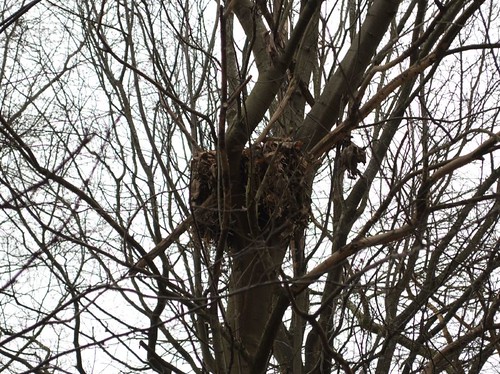 This is typical damage to a young oak, which will now never become a full-grown tree, although it may survive as a pollard. This is because the squirrels had "ring barked" it, preventing the flow of vital nutrients beyond that point:
This is typical damage to a young oak, which will now never become a full-grown tree, although it may survive as a pollard. This is because the squirrels had "ring barked" it, preventing the flow of vital nutrients beyond that point: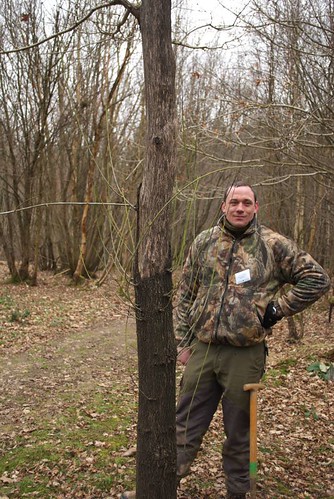 When the populations are over 5 per hectare, the greys are known to kill native trees through stripping of the cambium layer. They usually eat the sap from trees that are 10 – 40 years old and the damage in some woodlands can mean that some trees will not make maturity.
When the populations are over 5 per hectare, the greys are known to kill native trees through stripping of the cambium layer. They usually eat the sap from trees that are 10 – 40 years old and the damage in some woodlands can mean that some trees will not make maturity.
Grey squirrels also compete for food, nest sites and space with our native wildlife e.g. dormice, tawny owls, kestrel, woodpeckers, tree creepers, nuthatch, jay etc. Large populations of grey squirrels can cause instability to the carrying capacity of the woodland ecosystem.
Trap Types
Kania
One of the safest traps to set, is species specific and probably the most powerful trap you could use. Approx £50 each and you would require around 7-10 per hectare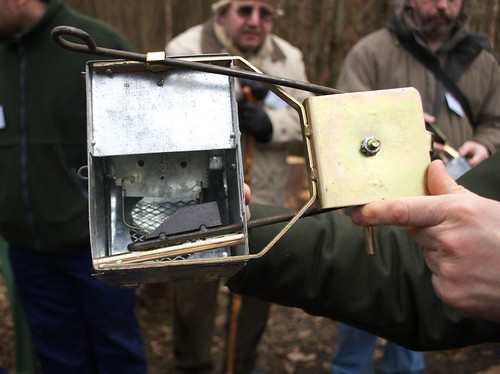 Here it is in action:
Here it is in action: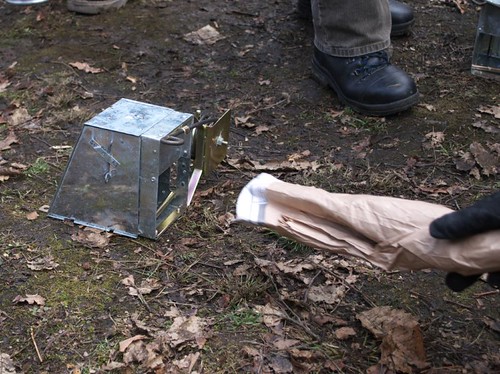
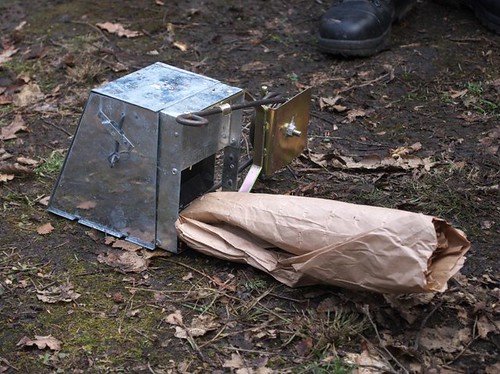 Wooden tunnel MK4/MK6 Fenn trap
Wooden tunnel MK4/MK6 Fenn trap
Sited in places and runs used by squirrels, a highly successful method of clearing large number of squirrels. The law requires that the trap is placed inside a tunnel. Approx £50 for 10 and you would require around 7-10 per ha. This does not include the cost of making the tunnels.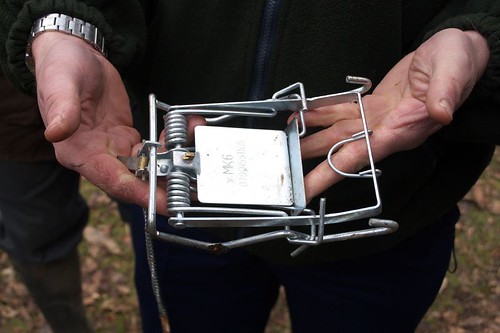 Clear the ground where you are going to lay the trap (this is so the squirrels can easily see the bait you place near the trap).
Clear the ground where you are going to lay the trap (this is so the squirrels can easily see the bait you place near the trap). Peg it to the ground (this is to stop badgers or foxes running off with the squirrel and the trap!)
Peg it to the ground (this is to stop badgers or foxes running off with the squirrel and the trap!) 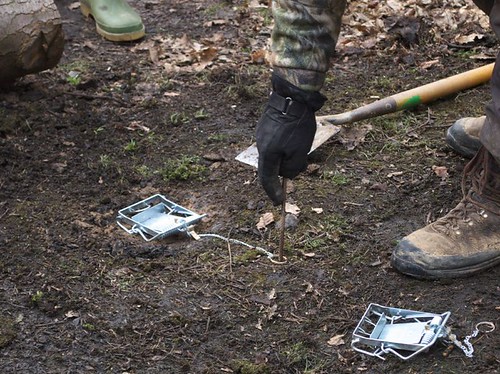 and cover with a wooden run. You must do this part to protect other animals from the trap. You can also disguise it by covering it with leaves. John will usually pre-bait areas for a few days with everything in place but the traps set not to go off, so the squirrels can get used to it being there.
and cover with a wooden run. You must do this part to protect other animals from the trap. You can also disguise it by covering it with leaves. John will usually pre-bait areas for a few days with everything in place but the traps set not to go off, so the squirrels can get used to it being there. Here's the trap in action:
Here's the trap in action: Multi/Single Cage Traps
Multi/Single Cage Traps
These traps keep the captured squirrel alive, which then of course, means you will need to kill them later (note that it is illegal to release a squirrel once trapped). £80 for a multi cage trap, £30 for single cage trap; around 4 multi cage traps would be required.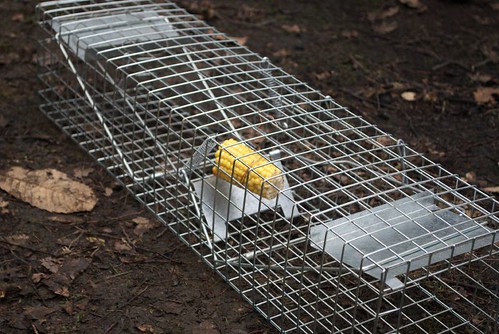
 Good bait to use is maize, peanuts and peanut butter. The best time of year to control the squirrel numbers is February and July, when they are breeding.
Good bait to use is maize, peanuts and peanut butter. The best time of year to control the squirrel numbers is February and July, when they are breeding.
We finished up with lunch round the fire, and then a chance for people to try shooting some different air rifles at a target. Finally, our friend Paul demonstrated another method of squirrel control that he uses - a "buffalo" shotgun cartridge. Here's what it does to a dray:
Here's what it does to a dray:

 The idea is to shoot through it when it's full of young squirrels, and have other people with shotguns waiting nearby to get any that run out of the dray. Messy, but effective - a few people can cull dozens of them across many acres in just a few hours.
The idea is to shoot through it when it's full of young squirrels, and have other people with shotguns waiting nearby to get any that run out of the dray. Messy, but effective - a few people can cull dozens of them across many acres in just a few hours.
Tuesday, 3 February 2009
Grey squirrel control workshop
Subscribe to:
Post Comments (Atom)

No comments:
Post a Comment